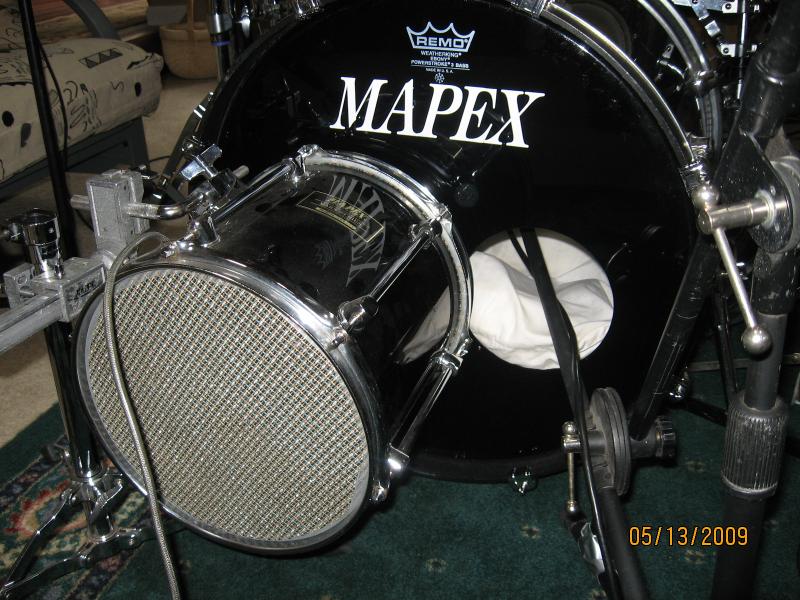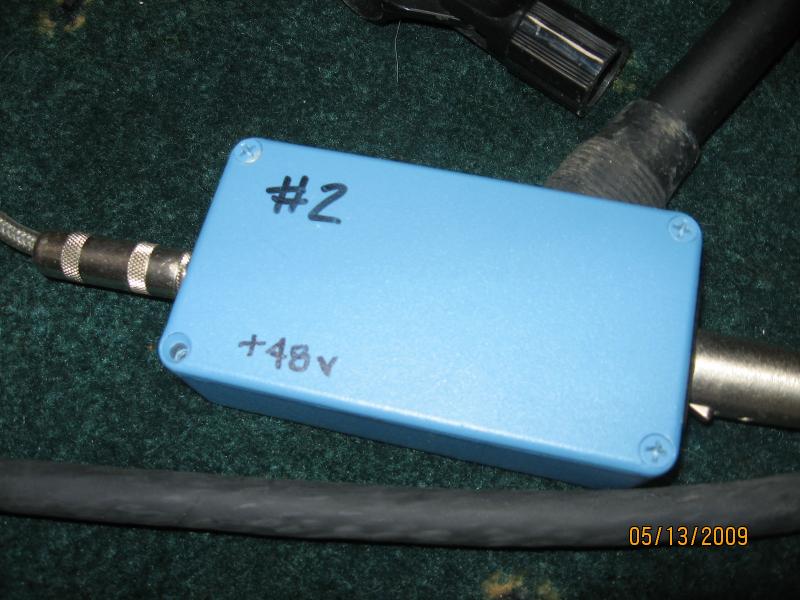Has anyone ever tried putting a heavy weight inside a kick drum (on a pillow) before? I was assisting on a session where a very reputable engineer/producer did this. He said the weight lowers the resonance of the drum and essentially makes the kick sound more tight. The weight also acted as a flat surface to place a Beta 91 inside of the kick. A Beta 52 also accompanied the 91, inside, and a U47 was used as kick out. The kick drum was then isolated with a few well placed blankets. It sounded very good, but I am not sure how much of this was directly related to effect of the weight. Any thoughts?
I'd also like to know of people's favorite techniques/microphones for getting a great subsonic kick signal. I am very familiar with the subkick/reversed speaker trick, but what are some other ways of getting a nice "rumble" from a kick that is maybe lacking a little low end, without throwing an 808 type sample underneath it.
Thanks
-DS
Topic Tags
Comments
For years I treated the kick drum with a slab of 6" foam, sliced
For years I treated the kick drum with a slab of 6" foam, sliced to just cover the bottom part of the curve and used a 20lb iron barbell weight on top of it. The edges of the foam piece were cut at angles so the foam formed a shelf and would be able to make contact , or not, with the beater head. The front skin was off. The weight kept it in place.
With the advent of sound control heads I stopped doing that. But might still, if the sound called for it.
Another trick was to line the entire kick drum with 2" high density foam. An early 'dead ringer' if you will. This created a very heavy 'punch' and was easy to mic. A D10 inside was about all it needed. I bought an old Slingerland 24" kick drum and did this to it. The head on the front was cut with a large center hole and the beater head had an extra thickness of batter glued into the center where the beater made contact. This was before the head companys did this for ya!
Sometimes we'd glue or duct tape a silver dollar to the impact area and use a wooden beater to get that huge 70's klick.
Once, while being bored, we got a second 24" shell and weighed it down with the barbell weights, and put the two shells together. We set two mics inside, a D10 and a Sennheiser MD409, the D10 inside the first drum and the 409 inside the fake shell. We put a head on the outside of the fake extension shell, mounted a Crown PZM to that head, and then covered it all in packing blankets. The rack was a 14" floor tom mounted on a stand and the floor tom was a 18". The snare was a cut-down marching snare, it was about 12" deep.......anyway, it was huge rocking sound....
Experimentation was always fun.
Nowadays, I use an ATM25 inside, and a Kel HM-1 on the outside. I like small kick drums...20 is a good number. With the right heads you can get every kick sound you could ever want with all the control in the world. Sometimes I'll use the sub-kick.
And I'm sure theres a lot of you who have heard of the snare trick from the sixties.......?? No?
Okay. You'll need a bass guitar cabinet with a 15" speaker in it that you can lat on its back while being plugged in. The ONLY plug I know that works for this is the Fender speaker plug from the Twins and Supers etc...Its flat, you see...
So you put the bass cab on its back and take the already recorded snare track out to a reamp device. Get an a amp of any kind...a Fender Bassman is what I liked to use for this but anything will work.....Take the signal and send it to the amp and speaker laying on its back....put another snare on the speaker right over the driver inthe cabinet....run the snare signal to it. Mic the snare...record it and blend it with the original snare.
If you plan this out you can actually use a klick track generated snare sound or even just a thump...The thing is, the sound you send to the speaker will be recorded as well as the snare thats being miced.....we did find that sending a signal of something like a drum machine thump gave you that Steve Smith Journey era snare sound.
One other little trick is to mic the beater side from the pedal side of the drum. A 57 works well for this. I always looked to get contact clarity with this.
All this crazy talk still works......
i never record a bass drum that way but i used to do that when i
i never record a bass drum that way but i used to do that when i was playing clubs.
i would put a folded blanket in the bass drum and put a cement block on it.
it gives it more of a solid thud sound and cuts through the band better,also i liked the feel of the beater hitting what felt like a solid wall.
these were small clubs and the drums weren't miked.
i could see it working really well recorded if your going for a tight thuddy/not much ring, bass drum sound.
BobRogers, post: 347016 wrote: So, what's the physics of the hea
BobRogers, post: 347016 wrote: So, what's the physics of the heavy weight? Are you just basically increasing the mass of the shell? Curious.
I cant speak to the physics of it Bob, but I would guess that it must do something of that sort because when I used that method it always delivered a lower and tighter 'thump' than the tuning of the drum itself. And, I dont believe it was simply damping the head a bit either.
Drewslum, post: 347062 wrote: Thanks for the advice/info! Dave,
Drewslum, post: 347062 wrote: Thanks for the advice/info! Dave, the drum shell you use for the housing doesn't affect the sound, just the speaker correct?
On the Sub-Kik?? No. The speaker is suspended inside that 12" tom. This one has an 8" speaker, I think... I think its medium heavy stretch cord like one would find on a tie-down or a bungee cord. I didnt build it. The 'new' 'heads' are done in classic Fender grill cloth. A nice touch. I have a tom I'm going to do in a similar fashion soon. Its also a 12 and has a beautiful 60's Black Oyster finish. Classic. I'm thinking a black grill cloth for this one.
for the down low on a kick drum the yamaha subkick or DaveDog's
for the down low on a kick drum the yamaha subkick or DaveDog's homemade subkick is what you want. i have also found in my room that a well place condenser 8 feet from the kick at 8 inches high produces the really open big Bonham sound (sort of, close) and true that a smaller kick does a really nice boom if tuned right.
I did the latest GarajMahal CD in conjunction with MOOG Music and Sean Rickman really packs his kick drum as if he's going on a really long vacation!!.....i was skeptical at first but it had the Bruce Swedien kinda sound, PUNCHY...there is a sample of it on my website [[url=http://[/URL]="http://www.p10studi…"]planet10studios - Audio[/]="http://www.p10studi…"]planet10studios - Audio[/], song is called "Of A Simple Mind" or "Make a Hippy Happy" if you all are interested. all i used was a Sennheiser E602 thru my Neve 8108 console, thats it, with an insanely good drummer not much more is needed....
Davedog, post: 347006 wrote: Nowadays, I use an ATM25 inside, an
Davedog, post: 347006 wrote: Nowadays, I use an ATM25 inside, and a Kel HM-1 on the outside.
How's that HM-1 sound by itself? I have a pair of those, never occured to me to try it on kick drum!
Davedog, post: 347006 wrote: And I'm sure theres a lot of you who have heard of the snare trick from the sixties.......?? No?Okay. You'll need a bass guitar cabinet with a 15" speaker in it that you can lat on its back while being plugged in. The ONLY plug I know that works for this is the Fender speaker plug from the Twins and Supers etc...Its flat, you see...
So you put the bass cab on its back and take the already recorded snare track out to a reamp device. Get an a amp of any kind...a Fender Bassman is what I liked to use for this but anything will work.....Take the signal and send it to the amp and speaker laying on its back....put another snare on the speaker right over the driver inthe cabinet....run the snare signal to it. Mic the snare...record it and blend it with the original snare.
A variant of that, which I learned & used to do in the late 70's, has the snare drum on its stand in normal "operating position", and with an Auratone 5C monitor face down on the batter head, supported by the plastic container ring that comes with a new reel of 2" tape. Drive it from one of the cue amps with a click or poorly recorded snare track, badda-boom/badda-bing.
BobRogers, post: 347016 wrote: So, what's the physics of the hea
BobRogers, post: 347016 wrote: So, what's the physics of the heavy weight? Are you just basically increasing the mass of the shell? Curious.
Davedog, post: 347045 wrote: I cant speak to the physics of it Bob, but I would guess that it must do something of that sort because when I used that method it always delivered a lower and tighter 'thump' than the tuning of the drum itself. And, I dont believe it was simply damping the head a bit either.
If I'm not mistaken it has more to do with reducing the interior volume (cubic dimension, not loudness, LOL!) of the drum than changing the resonant frequency of the shell. I.e., that foam block (or pillow) and weight are taking up space that otherwise would be taken up by air.








I'm guessing this engineer was going for a specific sound, as th
I'm guessing this engineer was going for a specific sound, as this seems a little overkill.
Kick inside/out is pretty standard - but 3 mics on a kick?
The blanket thing is pretty common too.
Combine both of those w/ the weight (which to my logic seems like it might work, though I'm not sure it's the sound I'd prefer)... it just seems a little crazy to me.
What I do for rumble (primarily for bass, but it works for kick as well) is put a nuclear LPF on a dupe of the kick track, and add some tube saturation.